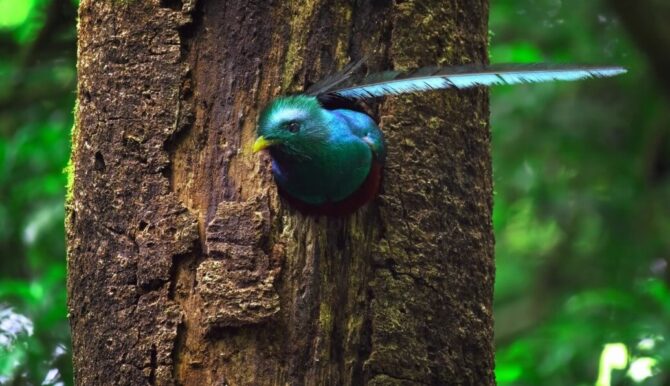The Urutau bird, also known as the “ghost bird” due to its eerie call and mysterious behavior, is a captivating species of birds found in forests in South America, Central America, much of Mexico, and some Caribbean regions.
This fascinating bird has a reputation as a harbinger of death and bad luck, adding to the mystery surrounding it.
In this article, we will share 20 fascinating facts and showcase images of the Urutau bird to provide a better understanding of this mysterious bird.
20 Incredible Facts about the Urutau Bird

The Urutau bird (Nyctibius griseus), also known as the common potoo or poor-me-one, is one of the seven species within the genus Nyctibius.1
This nocturnal bird is related to nightjars and frogmouths and has a stocky body and heavy bill.
One distinguishing feature of the Urutau bird is its large, distinctive eyes that can appear as giant black dots with small yellow rings or giant yellow irises with small pupils, depending on voluntary pupil constriction.2
Additionally, it has a wide mouth with a tooth in its upper mandible used for foraging.3
There are many fascinating aspects of this mysterious bird, some of which border on the mythical, and here are just a few of them:
1. It Has an Eerie Call
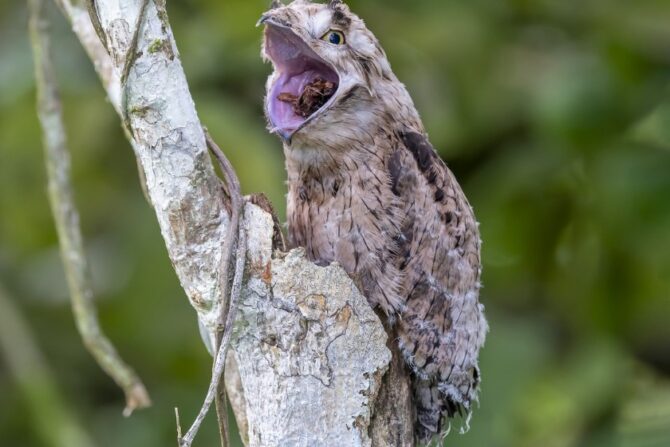
The Urutau bird is nicknamed “ghost bird” due to its eerie, mournful, and ghostly call.
Some believe its call symbolizes death, grief, heartache, and misfortune, but this is only superstition.
The common potoo, also known as the “poor-me-one,” has a sad, descending whistle that sounds like “poor, me, all, alone.”
In contrast, the great potoo, another species of this bird, has a loud bawl that can startle people unfamiliar with the night-time activity of tropical forests.
2. It is Nocturnal
The Urutau bird is difficult to locate due to its nocturnal behavior.
Bird watchers usually struggle to observe it, as it rests during the day with its eyes half closed and is more active at night.
The bird is adapted for nighttime hunting and flight, with large, shiny eyes for good night vision that can even reflect flashlights and headlights.
3. It Is Excellent at Camouflage

The Urutau bird is known for being evasive and flying away at the slightest disturbance.
Its disruptive coloration allows it to blend in with the trees in its habitat, helping it hide when a predator is near.
However, when this tactic fails, the bird opens its eyes and mouth to startle the predator and escape by flying away.
4. It Has a Unique Appearance
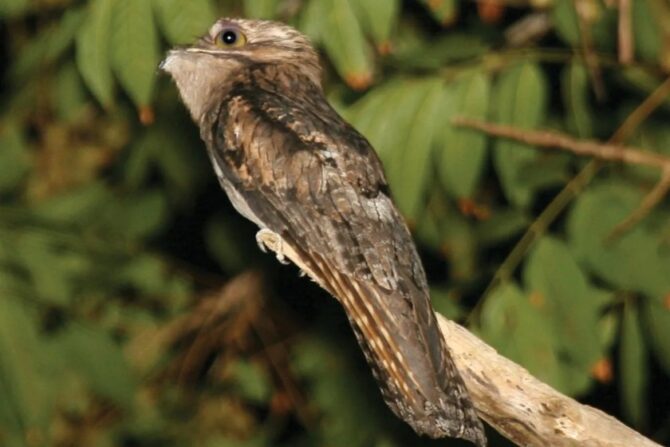
The Urutau bird has a peculiar look that distinguishes it from other birds.
It has a head, tail, and wings that are large compared to its body and a huge mouth that opens wide.
The most striking feature of this bird, even more so than the mouth, is its eyes, which are huge and frightening and can reflect torchlight.
Its irises are yellow or brown and, sometimes, one eye’s pupil may differ in size from the other.
The bird’s eyes may look exaggerated with a comically large size, bulging, or crossing, while others have normal eye proportions and angles.
5. Its Population Is Decreasing
Urutau birds are plentiful and distributed across a wide range.4
In 2022, at least 500,000 common potoos alone were recorded.
Nonetheless, the population of these birds is decreasing due to habitat destruction and deforestation.
While these birds are listed in the “Least Concern” category on the IUCN Red List,5 conservation measures still need to be taken to safeguard them and their habitat.
6. Urutaus Are Shy and Solitary
Although Urutaus may hunt near each other in pairs, they are primarily solitary creatures.
They are too timid to be considered friendly and spend most of their time concealed in tall tree branches.
They also do not live in communities with other birds of their kind.
7. It’s Hard to Differentiate between Male and Female Urutaus
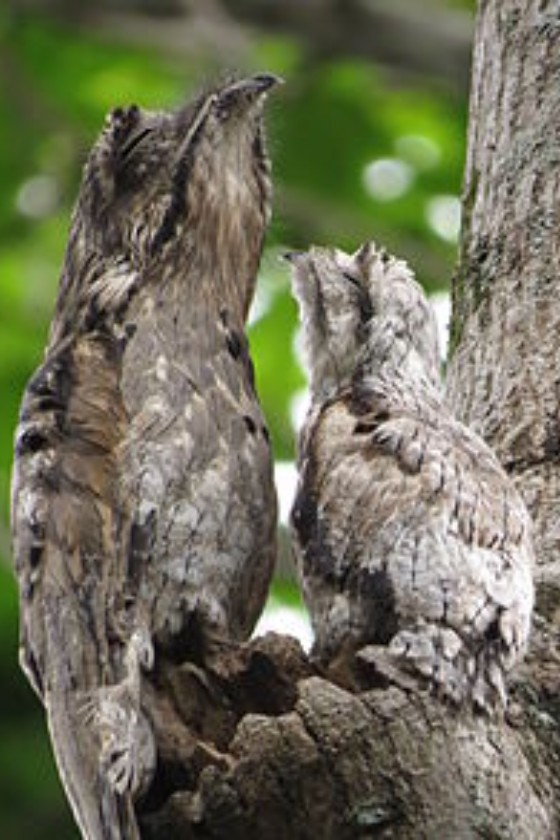
Ornithologists struggle to determine the gender of Urutau birds, as there is no visual distinction between male and female individuals.
This makes it challenging to observe their behaviors, such as hunting, nesting, and courting.
8. Its Lifespan Is Unknown
The exact lifespan of the Urutau bird is uncertain.
However, based on the lifespan of related bird species, it is estimated to be approximately 12 to 14 years.
9. Some Predators Prey on Urutau Birds
Despite their unusual appearance, Urutau birds are vulnerable to predators such as owls, snakes, weasels, falcons, howlers, spider monkeys, and capuchin monkeys.
They can fall victim to these predators as adults or have their eggs stolen from them.
10. Urutau Birds Aren’t Harmful to Humans
Due to their unusual appearance and odd vocalizations, potoos have been known to spark fear among humans.
However, these birds aren’t harmful to anything they don’t view as prey, and that includes humans.
11. Urutaus Don’t Build Nests

Urutau birds have limited nesting options.
Instead of constructing a nest, they locate a branch or stump with a depression or crack that is the exact size of the single egg they lay.
Then, they incubate the egg with body heat, much like a penguin.
12. It Has a Diverse Diet
The Urutau bird is rumored to consume the spirits of the deceased, leading to its association with death and bad luck.
However, this is just a superstition with no scientific backing.
The bird primarily feeds on insects such as moths, beetles, crickets, grasshoppers, and katydids.
Though infrequent, they may also prey on small birds or bats.
13. The Potoo Has Seven Species
There are seven species of Nyctibius ghost birds that form the distinct family Nyctibiidae.
This includes Nyctibius bracteatus, Nyctibius grandis, Nyctibius aethereus, Nyctibius leucopterus, Nyctibius maculosus, Nyctibius griseus, and Nyctibius jamaicensis.
14. It Is Strangely Attractive
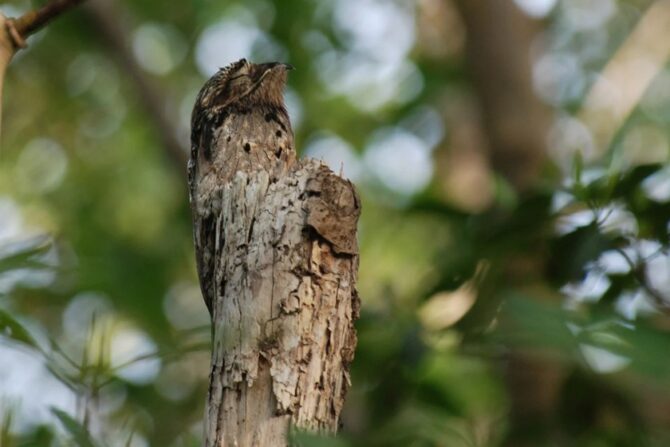
Although known for its mysterious and ghostly nature, the Urutau bird is both attractive and crucial to the South American environment.
15. It Can See with Its Eyes Closed
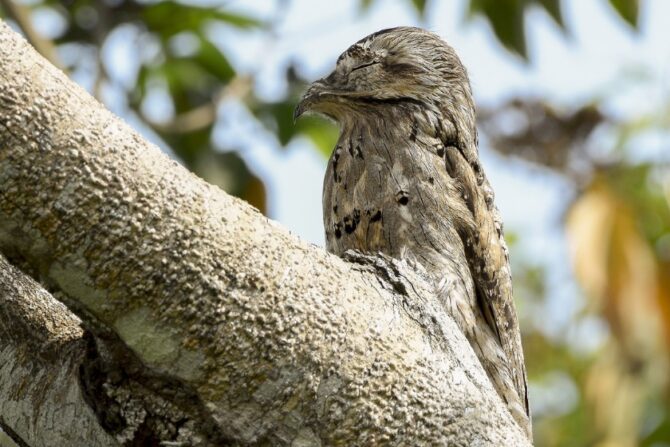
The upper eyelids of the Urutau bird have several small folds forming slits through which it can observe its surroundings during the day.
This adaptation allows it to look out for potential threats while remaining still and camouflaged and keeping its huge eyes closed.
16. Urutaus Are at Risk
Urutaus face several risks, including habitat loss due to deforestation and poachers who hunt them for their meat and feathers.
Fortunately, conservation efforts to protect their habitat and reduce hunting and poaching are underway.
17. It Has One Mate
Urutau birds mate with one partner and breed during the rainy season in their habitat.
18. Its Young Is Born with Its Eyes Closed
The offspring of an Urutau bird is called an Urusta.
At birth, its eyes remain closed, and its body is covered with light gray downy feathers.
Eventually, when it starts to open its eyes, it will grow brown and dark black-gray adult feathers, indicating that it’s now fully mature
19. It Can Fly So Fast
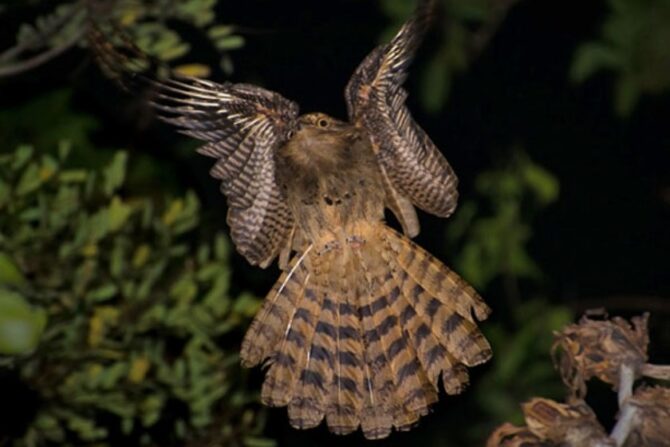
Although its exact highest speed is unknown, the potoo is known to fly at a relatively high speed.
20. It Can Catch Insects Midair
The Urutau bird has a wingspan of 30 inches and is highly evolved to catch insects midair, mostly due to its large mouth and relatively high speed.
Conclusion
Whether it’s this bird’s mysterious call, attractive appearance, or ecosystem significance, the Urutau bird will surely intrigue you.
Despite its superstitious link with death and misfortune, it remains a captivating symbol of mystery and beauty.
So when next you visit the South American forests, be on the lookout for this fascinating bird, and try not to panic if you hear a ghost-like call.
References & Notes
Facts Sources:
- Nyctibius griseus (Common Potoo). Avibase
- Notes on the Structure of the Upper Eyelid of the Potoos (Nyctibius). Oxford Academic
- Birds of Venezuela. WorldCat
- Common Potoo (Nyctibius griseus). BirdLife International
- Nyctibius griseus (Common Potoo). IUCN Red List of Threatened Species



